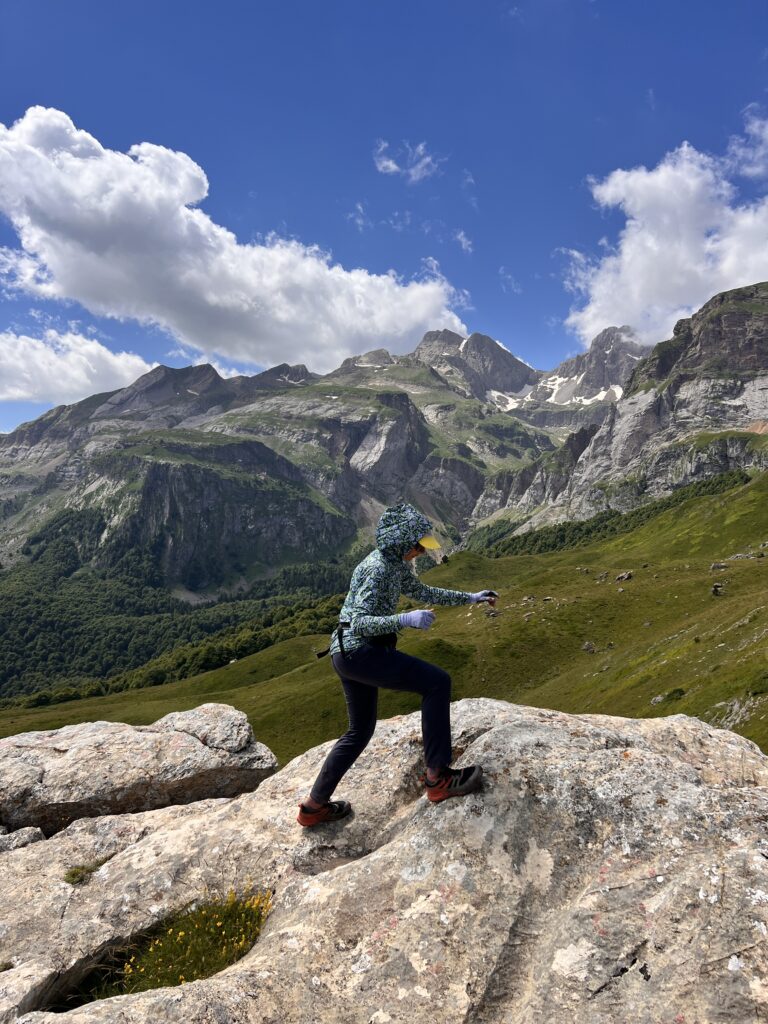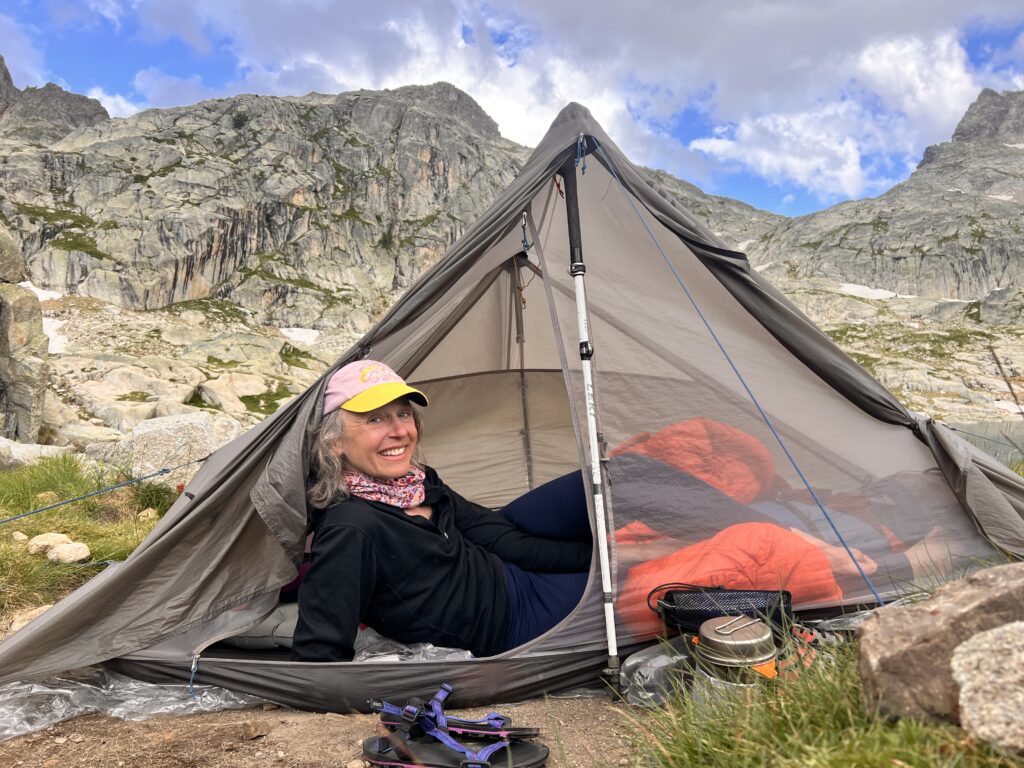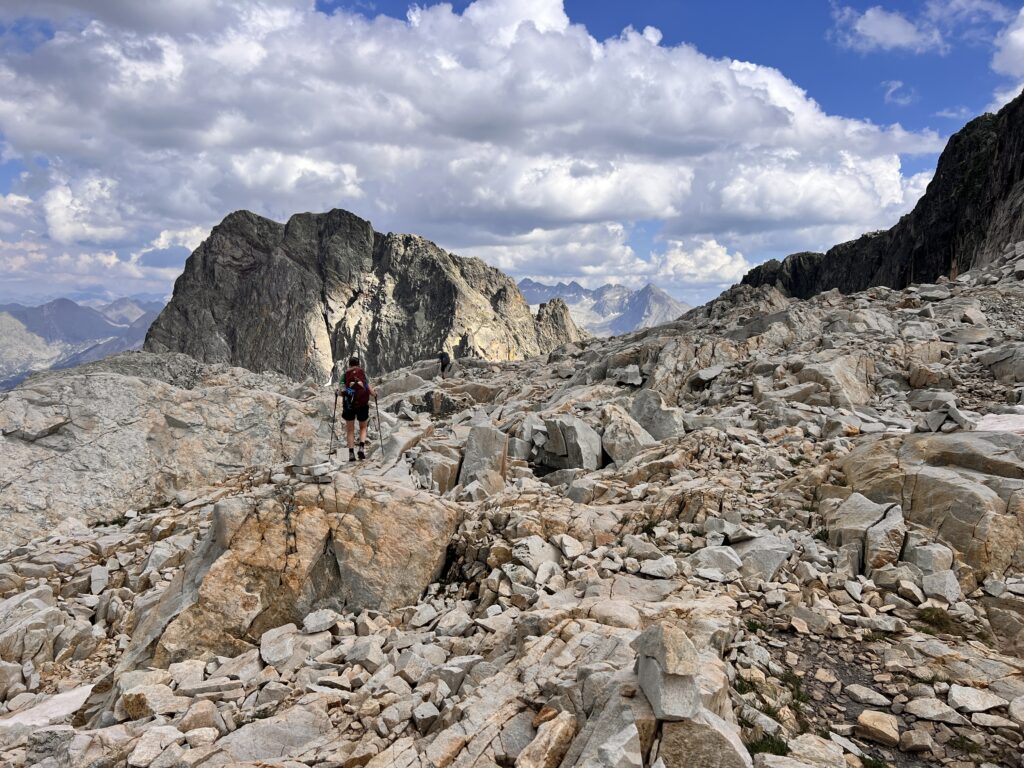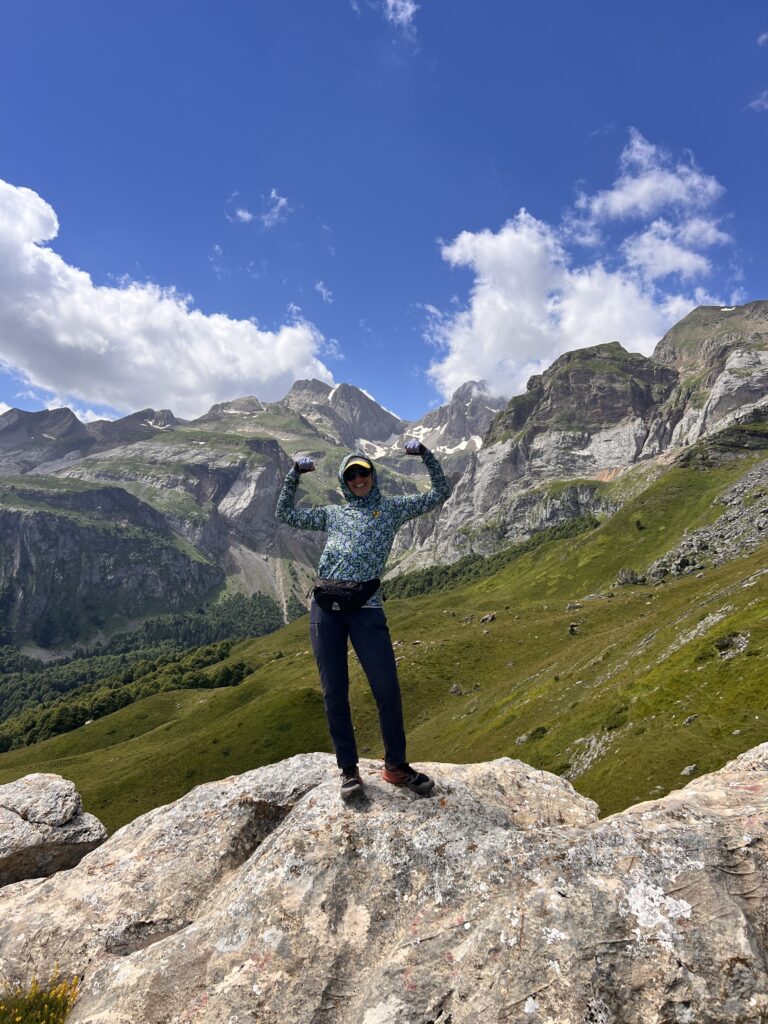
If you followed the final days of my Pyrenean Haute Route hike, you read about the oafish American man who questioned my ability to manage a route of this difficulty.
“Even YOU?” he asked, his lip curling in distaste. “I haven’t seen many old people hiking this.”
It was an unpleasant moment and happened right after I ate a tainted quiche. Sadly, I was unable to offer a snarky comeback and simply slunk away to a night of severe illness.
Feeling low and feeling old shook my confidence that I really had what it takes anymore to hike a route this tough. Truth is, as a 59-year-old cancer thriver with two fake hips, I had nearly finished the route and hadn’t skipped a single hard part.
Still, a cascading set of issues were piling up and finally forced me off trail. Looking back, I wonder what I might have done differently to set me up better for success.
But first, here’s something that did work.
Sleep System

A doctor once told me, “Good health requires rest, nutrition and exercise – and in that order.”
He was definitely talking to me since I tend to live more toward Governor Walz theory of living, “We’ll rest when we’re dead.” Here’s what I’ve learned: not resting can make us dead a whole lot faster.
Sleeping on the ground gets harder as we age. We have less cartilage to cushion our bones, we produce fewer hormones that allow us to stay asleep and many of us develop conditions that keep us awake us up at night.
Long, hard hiking hiking days are punishing on the body and require proper rest. So for this hike, I got myself a luxurious sleep system that’s still within reasonable weight limits for thru-hiking and all made by the terrific Australian company, Sea-to-Summit.
Pad
What I looked forward to most at the end of my day was laying down on my air mattress. The Women’s Ether LiteXT insulated air sleeping pad is cut for us wide-hipped ladies, so I never rolled off. With a 3.5 R-Value, it’s warm enough for 3-season hiking and floats four inches above the ground on cushioned springs. I filled it with air using its stuff sack in only five breaths!
Weight: 17.5 ounces
Size: a small log for the fireplace
Pillow
The pad sports a “pillow lock” of four bits of sticky velcro in a circle. This holds in place the anatomical Aeros inflatable pillow and soft cover in place. For years, I just rolled up clothes as a pillow. Nowadays, that means a stiff neck by morning. I don’t go anywhere anymore without my pillow which is as comfortable on my back as on my side. Incidentally, both pillow and pad have a one-way port that keeps the air in as you inflate, then dumps air out fast when time to deflate.
Weight: 2.1 ounces
Size: a man’s wallet
Bag
My brilliant orange Flame 25° sleeping bag easily opened up into a quilt when it was hot, which was most nights for this post-menopausal woman, though I was grateful to have all that down surrounding me on the two nights it actually was cold. It’s cozy, fluffy, ultralight, and packs to nothing.
Weight: 24 ounces
Size: a mayonaise jar
In addition, I picked up a large bit of polycro for a ground sheet which kept the tent dry as condensation covered the outside and inside of my single-walled tent.
Rest? Success!
More about my gear and where to buy it is here.
Nutrition

Eating well on trail is my Achilles heal. After about two weeks, no matter how much I eat, I cannot seem to keep the weight on. Spain and France both put an emphasis on white bread as a mainstay. While it fills me up, it left me longing for healthier choices like fruit, vegetables, beans, or rice.
I could feel my energy lagging as the hike continued, even though I’d seemingly eat enormous amounts. True, a hiker can burn an average of 5,000 calories per day. But it’s not about replenishing calories only, but replenishing them with the right food.
As we age, we lose bone and muscle mass and our nutritional needs change. It was ironically at Refugi Certascan – the place where I tripped on a stair and broke my foot – when I started to feel like myself again. They served a dinner of garbanzo beans and vegetables, whole grain bread and quinoa salad. The minute that food hit my stomach, it was as if I woke up from a bad dream.
But finding those ingredients to make my own meals was tough. Sometimes I was able to purchase overpriced, highly caloric and minimally portioned hiker meals, but mostly I relied on cheese, saucisson, baguettes, nuts and dried fruit.
That might be why I would eat and eat and eat but never feel full, because my body was desperate for specific nutrients. And that’s when, I’m embarrassed to admit, I would resort to quick fixes like gummy bears.
One of the best refuges on trail was at Portillon. They made a giant vegetable and meat-filled omelette for one of my hiking friends, Tamir and me, plus a hearty vegetable soup served with whole grain bread. Again, I felt revived. That might have been what I was searching for when I bought the tainted quiche…
Nutrition? Definitely needs work, possibly by taking a bus off-trail to larger supermarkets, bringing supplements or planning to eat at refuges more often.
Check out Backcountry Foodie for nutritious recipes
Exercise

I was crazy strong on this hike – until I wasn’t. Tamir and I had opposite skills. His was flying down steep slopes and skimming across boulder fields, while mine was ascending as if a butterfly, my feet hardly touching the ground.
Obviously, pacing yourself and “listening to your body” is key. But it becomes even more critical as we age when we might be nursing arthritis, inflammation, old injuries, and generally not quite being the person we were, even last season.
I just read an article about a horrible condition called rhabdomyolysis. This is when injured muscles die and release toxins into the bloodstream. It can shut down organs and even kill us.
Sounds lovely, huh?
The Haute Route had four days of highly exposed sections that I had no interest in walking alone. I was lucky to meet Tamir, Evelien and Floris and we took on these challenging sections together with encouragement, camaraderie and lots of laughs.
The only problem was they moved faster than me, so, to keep up and not end up walking alone, I had to push myself – hard. Quite honestly, those long days skipping on boulders and navigating steep slopes exhausted me. I might have been more successful lagging behind and walking shorter days, especially after it was no longer necessary to stick close together.
Over time, I developed a “Runner’s Hack,” a cough brought on by heavy breathing at altitude. Because we have less of a filter between our mouths and lungs as opposed to our noses, we are at risk for infection. Once my cough started, hiking got harder. The advice to avoid developing this type of cough is pretty obvious: do not over-exert.
Exercise? Probably a bit too much. It might have been wiser to slow down and take a zero on trail.
Read “Meet the Old Lady on the Trail”
Conclusion

A wise woman who’s hiking into her 80’s once told me not to compare myself to younger hikers – or even to my younger self.
As we age, we don’t bounce back the way we did when we were younger. That means being far gentler with ourselves by getting a good night’s sleep (plus lots of breaks) eating nutritious meals to fuel our hike and backing off on taking on big distances just because you can.
After all, as older people we have less time to do all the things we want to do, but we’ve had long lives with tremendous experiences. Why not savor each experience fully?
And the next time some idiot acts shocked that someone of our age is out there hiking, we can simply smile and reply, “Yup, even me!”


16 Responses
Alison, thanks for another thoughtful enlightening candid text! As to the age issue, why do other people’s negative opinions matter? Please give them no space in your wonderful life!
TRUTH! as a wise person once said, “What other people think of me is none of my business!”
Very nicely written post about hiking at age! I can so relate to your thoughts, although my experiences as a fellow-59-year-old HRP hiker, 4 weeks behind you, were a little different.
By the way, I have not met any other (in particular solo) lady our age who did the entire through-hike (I am not counting the few days at the end which you had to skip, you anyway had the intention to do it all). So I think both of us can be extremely proud to have done it!
I did get a couple of comments about age which annoyed me, too. People would just talk to me for a while, then ask bluntly ‘may I ask what your age is?’. I usually gave it away, but I was not amused. It has a touch of ‘oh, I can see in your face that you are not that young any more’. So why do you have to remind me? I do not actually feel old, and to be honest, I don’t think I am much slower or have less endurance than when I was in my 20s. In fact, I am much more adventurous (as well as experienced) nowadays, I never would have dared to do the HRP solo at the age of 20. And I am quite convinced I was never in my life as fast as all those young French and Spanish guys and girls who are just running through the HRP. Interesting fact, it was only ever men who asked me that question about age. And nobody would ever ask a man that same question. When I reacted a bit surprised or annoyed they would just quickly say ‘oh, no, I am impressed that you are still doing this at your age, I mean it in a positive way.’ Well, just keep your mouth shut.
My sleep system was my weak point on this hike. I had newly purchased a Thermarest Hyperion sleeping bag and my Thermarest NeoAir XLite had just been exchanged by Thermarest, as my old one had kept losing air during the night. Well, it was an awful combination, for the following reasons:
– Those two together are super slippery, and I kept slipping off the mat all the time during the night
– The Hyperion’s zipper starts very high up, so it’s not possible to hang out your legs on warmer night, a total no-go for me, I was overheating then
– It was the contrary on the many cold nights. The Hyperion claims a comfort temperature of 0°C and a xxx temperature of -6°C. Well, this is ridiculous, I was always cold when it was 10°C or below
I contacted the Cascade Designs (to which Thermarest belongs) customer support twice about these issues. The first time they told me I should use the straps to attach the sleeping bag to the pad. I did try this a number of times, but it did not much improve the issues and it also does not work well for me as I toss and turn a lot during the night. The second time I contacted them after the hike to voice my unhappiness again, but this time they did not reply at all. While in the past I have been always extremely happy with the Cascade Designs customer service, I was not this time.
As a result of these issues I had a lot of sleepless nights and needed to sleep in huts, gîtes d’etapes and hostels more often than I had planned, in order to at least catch up with sleep sometimes.
On the other hand, I took care of my nutrition pretty well on this trip. I purposely ate quite frequently at huts (when convenient), as in particular the French (but most times also the Spanish) dinners were usually delicious, nutritious and copious and this helped me a lot staying healthy throughout the trail. Also, I feel trying the local cuisine is part of the experience travelling/hiking in another country. Like you, I did not like the often white-bread-based breakfasts too much, so I more often ate my own oat meals. I have learned on past hikes, that if I don’t eat enough and not enough healthy food, then I will get sick easily and at altitude sickness stays around for a long time. This time I only had a flue for a couple of days and it went away quickly. And no injuries, thank god. So that was a well applied Lesson Learned from the past.
Regarding exercise, I decided to walk in my own rhythm, which meant I could not hike with others most of the time, as the majority of the other, mostly young hikers were way faster than me. So it was somehow a shame in that it meant that socializing was mostly restricted to the evenings at camp site or in the huts, but I know that it’s not good for me to hike too fast. I did walk a couple of times with others, though, when it worked well.
So, we had similar, but slightly different experiences, and we both have our own fields to improve next time :-).
Thank you so much for this wonderful comment, Sonja! I definitely learned a lot on this hike. Sleep was a success! And walking too fast with the young ones, not so much 🙁 Still, what a marvelous experience we had! I am only sad we were a month apart and never met on trail. I hope to remedy that and will contact you about anther European walk I would like to take. Stay tuned, my friend and happy hiking. Blissful
A nicely paced and well-written article Alison, with interesting insights for the aging athlete. I remember being on a mountaineering expedition in my 40’s, 5 days on the hill getting by on a few freeze-dried meals, some gels, and a bowl of noodles or two and cups of black tea, and having to crank upwards every day. I could not ask that of my system now. Inevitable changes in our bodies, muscles/ joints/cartilage limit what we can expect, particularly if it is demand-based. When you had to pick up the pace, with those younger friends you met, it resonated. It would have burned through your carefully husbanded reserves. Getting gastro just the pits, and that guy and his comments, well most likely projecting his own fears and insecurities. Most of my active life I could get by eating anything, a preference for good food maybe. In my 60’s I find myself naturally looking for nutritional content in a way I never did before. Great trip and blog, an extremely difficult route and you were so very unlucky not to finish.
Cheers, John
thanks John! I would have just marched on if I hadn’t eaten that quiche – but then where would be the learning?! I feel supremely lucky I mey the young hikers and did so much. Now I need to practice what I preach. 😉
Wow, I can’t believe that guy said that! He was obviously oblivious!! I hope fate sends him to your blog so he can have a mind reset!! Your adventures and outlook are amazing!!! Thank you so so much for sharing!!
I was so inspired when I met a couple in their 70s who had just done the Grand Canyon portion of the Arizona Trail — in one day, if I remember right! I was sure they were in better shape than I was at 30! They also were wearing sandals and had made the choice (which they were admittedly regretting) of just packing granola bars instead of having to use water for reconstituting meals. Speaking of nutrition… Not that I’m judging!
I do feel the nutrition thing so hard! I too tend to have trouble keeping weight on when doing rigorous activities for long stretches of time, and I’m sure I didn’t do the best job of fulfilling all my needs when I was on my 3-month-plus trip. Well, palate-wise, if not nutrient-!
This is a bit longer than I intended. Anyway, once again, you and your adventures are amazing!!
thank you for sharing this! I think I will make it a goal to try to keep ON weight from here on out. It might be like the mattress, that I carry a bit more, but could be well worth it. Also, not going quite as intensely means I don’t need as many calories. And so it goes!